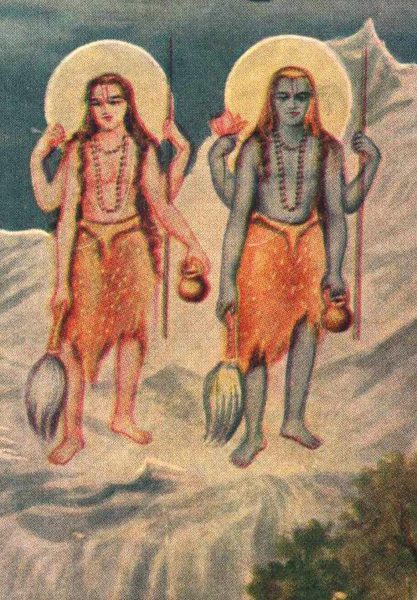Nara and Narayana are two sages who are mentioned in the Bhagawat Purana as the twin Avataras of the Lord who are ever engaged in restoring dharma. Dharma, in the Indian conception is of course neither righteousness as we understand it, nor any human or man-made moral, social and religious laws. Dharma refers to the cosmic order, the subtle laws that govern creation and are embedded in it. These laws are everywhere and their purpose is to build a cosmic order out of a primal indeterminate state. Each species, each element, each aspect of creation therefore has its dharma which it faithfully observes so that the cosmic order and balance is maintained.
But since the creation we live in is not a static creation but an evolutionary one, dharma also has within it the means for us to evolve, in fact for the whole creation to evolve. Secondly these laws are the means given to man to consciously evolve towards a higher and greater life, towards a state of ascending perfection. The purpose of this evolution is the same as that of creation itself and it is to manifest the Divine Unity and the Divine Perfection out of which creation as emerged and continues to emerge further and progress. But since creation is not a static thing and the intended Divine Perfection was not completed in seven days nor in seven billion years hence the process goes on and will go on. But this progression itself cannot become chaotic, it must follow its own laws so as not to disturb the total balance of things.
 In this process of a progressive divine manifestation man is the middle term wherein this hitherto unconscious process (unconscious for the species but conscious as far as nature in its vastness is concerned) man occupies an important place. Through man this process of progressive manifestation is purported to become conscious and hence take place in a more deliberate manner. Dharma is therefore the means given to man, the attitudes, the actions, the inner state and the outer conduct through which he can progressively align himself to the Divine Will working in creation and thereby become a supreme means for a conscious evolution. The need of a conscious process also necessitates that man be given some kind of a free will, however temporary it may be. Hence man has a choice to either align with the Cosmic Will and thereby practice dharma or else oppose it and hence make use of his seemingly free will for adharma.
In this process of a progressive divine manifestation man is the middle term wherein this hitherto unconscious process (unconscious for the species but conscious as far as nature in its vastness is concerned) man occupies an important place. Through man this process of progressive manifestation is purported to become conscious and hence take place in a more deliberate manner. Dharma is therefore the means given to man, the attitudes, the actions, the inner state and the outer conduct through which he can progressively align himself to the Divine Will working in creation and thereby become a supreme means for a conscious evolution. The need of a conscious process also necessitates that man be given some kind of a free will, however temporary it may be. Hence man has a choice to either align with the Cosmic Will and thereby practice dharma or else oppose it and hence make use of his seemingly free will for adharma.
Nara and Narayana literally mean the human (Nara) and the Divine who dwells within the human body (Narayana). Together they win the victory and guard the dharma. Implicit within this is the idea born of spiritual experience that man is an instrument of God’s work just as Arjuna and Krishna (who were incarnations of Nara and Narayana). Our real business is to align our thoughts and feelings and will and actions to the Thought and Love and Will and Force of the Divine. The more we are able to do it the more we become as a dynamo for God’s work and help creation move forward along the steps of Light marked out for our evolution by the Divine Law (Dharma). Equally the more we deviate from the Divine Will, the more we become the cause of adharma and the ensuing confusion and chaos. It may be however noted that as indicated earlier dharma and adharma are not decided to any handbook of mental rules. It is inbuilt within each one and one has to be very quiet, one has to quieten the mind’s noise and the restless storms of desires and passions to discover this dharma engraved upon our souls.
This is the symbolic meaning of the story of Nara and Narayana, the twin sages engaged in meditation as well as battle. It is said that when the two join then there will be a new Satyuga upon earth, which is clearly a symbol of man uniting with God which will usher in an age of everlasting Truth and Harmony and Beauty and Delight.



About Savitri | B1C1-10 The Response of Earth (p.5)